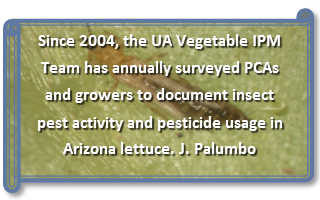
|
|
|
|

|
|||
|
|
|||
|
Since 2004, the UA Vegetable IPM Team has annually surveyed PCAs and growers to
document insect pest activity and pesticide usage in Arizona lettuce through interactive
workshops. We will be holding the 2015 Lettuce Insect, Disease and Weed Losses Workshop
next Wednesday, April 8 at the Yuma Agricultural Center beginning at noon (lunch
is provided at no cost). The information provided by PCAs and growers during these
workshops can be very useful to the local produce industry. First, the data can
be extremely helpful in addressing state and federal regulatory issues by providing
“real world" information on insect pest status and insecticides usage.

Remember, When in Doubt . . . . . “SCOUT”
Click picture to listen to John’s update
To contact John Palumbo go to: jpalumbo@ag.arizona.edu |
|||
| Back | |||
|
For questions or comments on any of the topics please contact Marco Pena at the Yuma Agricultural Center.
|
|||
|
Home |
Cotton | Veggies |
Forages | Grains
| Citrus |
Crop x Crop Insects | Diseases| Weeds | Pesticides | Economics | News | Weather | Research | Photos | Contacts | General Info. Copyright © 2001 University of Arizona, College of Agriculture and Life Sciences Webmaster: Al Fournier (acis@ag.arizona.edu) |
|||
